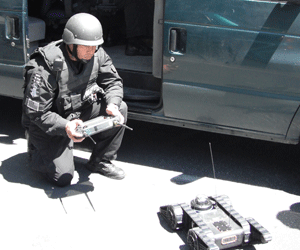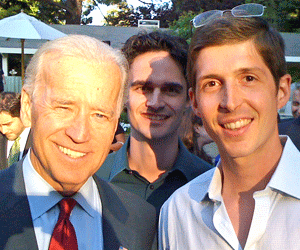Note: This article is over a year old and information contained in it may no longer be accurate. Please use the contact information in the lower-left corner to verify any information in this article.
Avatar robots to the rescue
September 28, 2010
|
|
| Adam Gettings '04 (right) has demonstrated his Avatar robot to Vice President Joseph Biden. |
Adam Gettings '04 makes his living building robots — but they aren’t the ones you played with as a kid. These robots are joining the ranks of SWAT teams in California and earning their keep getting thrown through windows and being driven into buildings with hostage situations.
Gettings co-founded his company, RoboteX, after meeting former Dreamworks Art Director Terry Izumi, who suggested that they figure out a way to make robots to help save soldier’s lives in Afghanistan and Iraq. Gettings, along with his brother Nathan, formerly a leader at PayPal, and Yu Pan, the founding engineer at PayPal and YouTube, took the idea and ran. “We started out by building crazy concepts that got us a lot of attention, like robots with machine guns attached to the top. We could get meetings with anyone,” he says.
After catching the attention of Silicon Valley leaders, they found that what was most compelling to people were safety robots. Gettings and his brother created and trademarked the “Avatar” robot that was designed for commercial safety purposes. The first police station to fully integrate the robot into everyday routines was the Oakland Police Department.
“The robot is a phenomenal tool,” says Sergeant of Police for the Oakland Police Department Shawn Knight. “It’s only a matter of time before we see documentation of the robot saving an officer’s life.”
 |
| Avatar being deployed by Oakland SWAT. “It’s only a matter of time before we see documentation of the robot saving an officer’s life," says Police Sergeant Shawn Knight. |
The Oakland Police Department sends robots in before officers in order to clear buildings and ensure that no one inside is armed. They can also be used in hostage situations because they have microphones to allow police to reason with the suspect without having to enter the building. Additionally, the robots are equipped with video cameras that can record what happens inside the building. If the suspect does something illegal, the tape can be used as evidence.
Affordable lifesaver
Knight believes that every police department should have two or three robots. “We lost several officers a couple of years ago, and having a robot would have given us another tool so we knew that the armed suspect was in there waiting for us. I’m almost 100 percent sure that the deaths wouldn’t have happened if we would have had a robot,” he says.
Gettings says that since they are affordable and can be programmed for many different uses, police aren’t the only group interested in these robots. Fire stations have also begun to use them to assess the risk of sending firefighters into unstable buildings and to search for victims still trapped inside.
Next year, Gettings plans to have the robot available for university security contingents to use in case of bomb threats. Soon, he hopes to have platforms for universities to give virtual tours to students who cannot visit campus and robots to investigate gas pipeline leaks. RoboteX plans to go global in Asia, Europe, and the Middle East next year.

